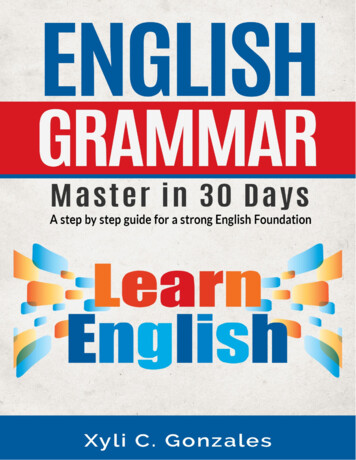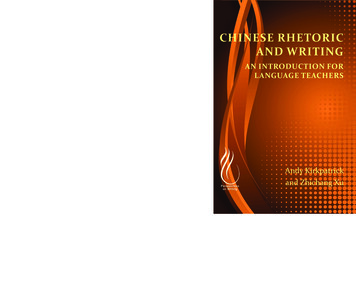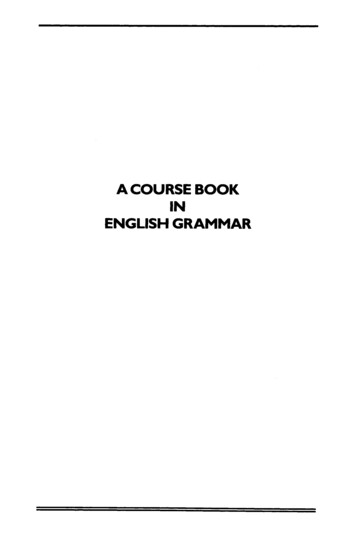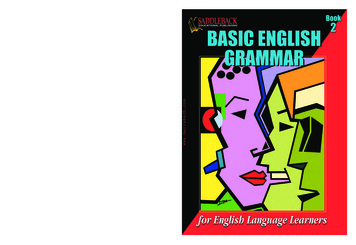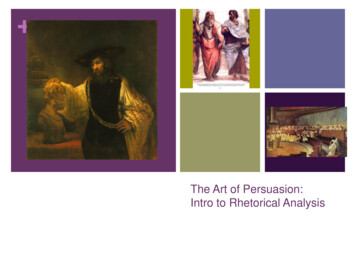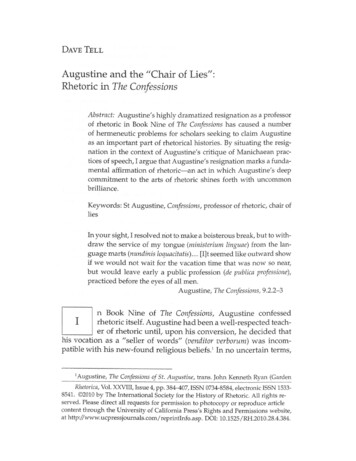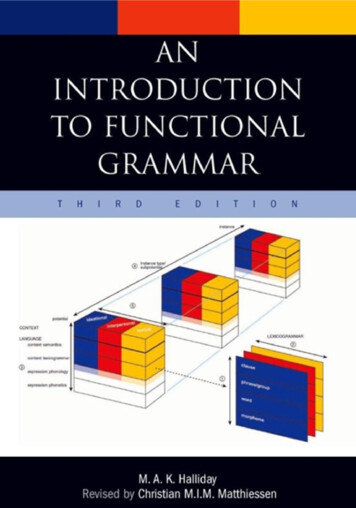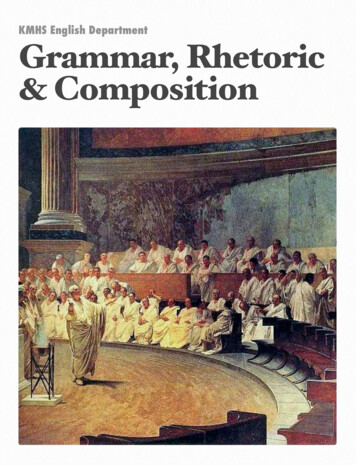
Transcription
KMHS English DepartmentGrammar, Rhetoric& Composition
IntroductionOxford UniversityEnglish, the language of Shakespeare, Milton, Joyce, and countless other great minds, comes tous through the family of Germanic Languages descended from an earlier tongue called ProtoIndo-European. It is through this common ancestor that English shares its similarities to Latinand the Romance Languages. The peculiar history of our language accounts for its unusuallylarge vocabulary, flexibility, and many idiosyncrasies. As a result, learning and mastering theEnglish language is truly the work of a lifetime. To commence this study, we will begin withindividual words, proceed to various types of word groupings, and conclude with the study oflarger compositions.i
Just as the aim of grammar study is to provide the student with an understanding of clear usage,this text will aim at clarity in its explanations and examples. All efforts have been made toensure ease of understanding.In presentation, rules are meant to be descriptive, rather than prescriptive. That is, theexplanations offered convey how the English language has been used effectively based on thenatural and historical course of language development instead of arbitrarily imposing asupposed order on the language itself. Language, itself a human construct, is a living, breathingcommodity that changes each day. Therefore, writing down its rules is akin to shooting at amoving target. However, in the attempt, the language’s essence often reveals itself. A student’scareful observation of the rules described in this text will create a reader, a speaker, and a writerof considerable confidence, fluency, and precision in one of human history’s most expressivetongues.Built into this book are numerous practice exercises meant to reinforce the rules and examplesprovided in the text. By tapping the links to these exercises, you may open them in anapplication to complete and save the work. Be sure to follow the instructions of your teacherfor how and where to complete and save this work.Throughout the book, you will also see the “thought bubble” in the margins of the text. Thethought bubble will offer you more detailed explanations, memory aids, or tips to help betterunderstand the concept being discussed. Simply tap the thought bubble to access theexplanation. Be sure to scroll within the pop-up text.ii
1The Parts of Speech“No study of literature can yieldits highest result without theclose study of language, andconsequently the close study ofgrammar.”– Basil Gildersleeve
OverviewEnglish words may be divided into eight types called parts of speech. These parts of speechare distinct from one another in their function. Taken together, the eight parts of speech makeit possible to express complete thoughts of great simplicity or complexity.A noun names a person, a place, a thing, or an idea.A pronoun takes the place of a noun.An adjective modifies or limits a noun or pronoun.A verb expresses an action or a state of being.An adverb modifies or limits a verb, an adjective, or another adverb.A preposition shows the relationship between a noun and some other word in a sentence.A conjunction joins together words or groups of words.An interjection expresses emotion.4
NounsA noun is essentially a naming word. It may refer to any person, place, thing, or idea. Nounshave the quality of number, which means that they may be singular or plural. A singularquantity refers to one person, place, thing, or idea. A plural quantity refers to two or brarylibrariesbusbusesAs you may observe from the table above, many nouns in English form their plural by adding -sor -es to their singular form, but exceptions are plentiful.Common NounsA common noun is a general name for any person, place, thing, or idea. It takes a lowercaseletter and may be preceded by an article (a, an, or love5
Proper NounsA proper noun names a specific person, place, thing, or idea. It takes an uppercase letter.ProperNounpersonPeterplaceNew YorkthingMacintoshideaChristianityExercise 1James A. H. Murray, editor of the Oxford English DictionaryCompound NounsA name composed of two or more word forms is called a compound noun. In English, thesetake three forms:%open form: where the word forms are kept separate, as in lawn chair or guitar case%hyphenated form: where the word forms are linked by a hyphen, as in wire-cutter or % %%%"closed form: where the word forms are joined, as in firefly or eyewitnesseye-opener6
If you are unsure about the spelling of a particular compound noun, be sure to check a reliabledictionary.For the Love of Language:Many compound nouns are born of necessity and gain slow acceptance into the English language. For example, withthe developing film industry in the early twentieth century came a term describing a script written directly for amovie, a screen play. This term was originally written as two separate words (in open form). Gradually, it came to behyphenated as screen-play. Then, when the term had gained enough currency, it became written as one word (closedform), as we would expect to see it today: screenplay. This evolution shows one of the many ways in which ourlanguage changes over time. While this exact process may not occur with every compound noun, it has alsohappened to common terms such as basketball and baseball.Collective NounsA noun that names a group of items is called a collective noun.%a class of students% %%a platoon of soldiers% %%a troupe of dancersIn most uses, the collective noun is treated as a singular unit.Exercise 2A murder of crows7
Concrete NounsAny noun that denotes a tangible, material object is a concrete noun. These nouns may beperceived by the five senses.%flower""sweetness" ""heat"""tone"""odorAbstract NounsThe name of any idea or concept that cannot be perceived by the senses is said to be anabstract noun.%love"""patriotism"""fear" ""intelligence""evilExercise 3Samuel Johnson, lexicographerNoun Review""8
PronounsA word that takes the place of a noun is a pronoun. Pronouns exhibit the qualities of gender,number, and case. A pronoun’s gender tells if it is masculine, feminine, or neuter (has nogender). Number, as with nouns, shows if a pronoun is singular or plural. A pronoun’s caseshows its grammatical relationship to the rest of the sentence. Put another way, the pronoun’scase shows the role that the pronoun plays in the sentence (e.g., a subject, an object, or apredicate nominative). Case will be handled in more detail in the chapter on Parts of theSentence.There are many types of pronouns, each with its particular use.Personal PronounsIn addition to gender, number, and case, personal pronouns also exhibit a certain grammaticalperson. first person refers to the person (or people) speaking second person refers to the person (or people) spoken to third person refers to the person (or people) spoken aboutThe personal pronouns are as follows:PersonalPronounsSingularPluralfirst personI, me, my, mine, myselfwe, us, our, ours, ourselvessecond personyou, your, yours, yourselfyou, your, yours, yourselvesthird personhe, him, his, himself,she, her, hers, herself,it, its, itselfthey, them, their, theirs,themselves9
Reflexive and Intensive PronounsPersonal pronoun forms may have -self or -selves added to them to form the reflexive or intensiveform.first personmyself, ourselvessecond personyourself, yourselvesthird personhimself, herself,itself, themselvesThough reflexive and intensive pronouns use the same form, their usage is different.A reflexive pronoun refers to (or replaces) the subject of a sentence and functions as acomplement of the verb (this will be explained later in Parts of the Sentence) or as an object ofa prepositional phrase (this will be explained later in Phrases).%I allowed myself plenty of time to drive there."The boss gave himself a huge raise."Jill and David left a lot of work for themselves.An intensive pronoun merely adds emphasis to the word it replaces.It has no grammatical role to play in the sentence.%He finished the pizza himself."I myself had to check the answer."Check the movie times yourself.Demonstrative PronounsA demonstrative pronoun points to a person, place, thing, or idea.this%thatthesethoseThat is the jacket he wore to the game.10
"It will be difficult to sell these tickets.Note in the second example that the pronoun these is used before a noun. In such a case, theword is called a demonstrative adjective.Interrogative PronounsA pronoun used to introduce a question is called an interrogative pronoun.whowhomwhich%Who told you about the party?"Which of these sweaters do you like best?whatwhoseRelative PronounsA relative pronoun introduces a subordinate clause. Subordinate clauses are groups of wordsthat contain a subject and verb (these will be explained in the chapter on Clauses).thatwhichwhowhomwhose"My friend who grew up in California is named Stephen."The Empire State Building, which was constructed in 1929, is an iconic"symbol of New York City.Indefinite PronounsA word that refers to a person, place, thing, or idea not specifically named (or not specificallyknown) is an indefinite each ostmuchneithernobodynoneno onenothingoneone h11
%Could someone tell me the way to the cafeteria?"Each of the teams must win to advance to the finals.Exercise 5"Noah Webster, lexicographerPronoun Review12
AdjectivesAn adjective is a type of modifier, a word that limits or describes something else. Adjectivesmodify nouns or pronouns. Adjectives may be thought of as answering specific questions aboutthe nouns or pronouns they describe.%Which one?"The gray suit"What kind?"A plastic cup"How much?"Adequate time"How many?"Three dollarsThough adjectives typically stand in front of the noun or pronoun they describe, they may beseparated from it.%An impressive victory."That victory was impressive.In the second example, the adjective follows a linking verb and describes the subject of thesentence. This is called a predicate adjective and will be discussed further in the chapter onParts of the Sentence.The most frequently used adjectives are called articles (a, an, and the). Since a and an may referto any one of a general group, they are called indefinite articles. Since the refers to a specificmember of a group, it is called the definite article.(Please note that a is used before a word beginning with a consonant sound, while an is usedbefore a word beginning with a vowel sound.)13
Many words commonly used as nouns or pronouns may also be used as adjectives. When theword stands on its own as a person, place, thing, or idea, it is a noun or pronoun. When itstands in front of some other noun or pronoun and describes it, it is an adjective.%A green salad (noun)"""""Those are my glasses."(pronoun)""A salad bowl (adjective)Those glasses are broken. (adjective)%Exercise 7The Eiffel TowerAdjective Review14
VerbsA verb expresses an action or a state of being.%I waited for hours."He was the class treasurer."My friends were leaving in ten minutes.A sentence may contain a verb phrase, consisting of a main verb and one or more helpingverbs (also called auxiliary verbs). Helping verbs often indicate the tense, voice, or moodof the verb.Tense refers to the time of an action or state of being. Voice refers to the relationshipbetween the subject and the action. Mood refers to the attitude toward the action or state ofbeing. Helping verbs that indicate mood are called modals. The qualities of tense, voice, andmood will be discussed in more detail in the chapter Verb Usage.Common Helping Verbs:%Forms of be: am, is, are, was, were, be, being, been%Forms of have: has, have, had, having%Forms of do: do, does, did%Modals: can, could, may, might, must, ought, shall, should, will, wouldSometimes, particularly in questions, a helping verb will be separated from a main verb in asentence.%Will you help me with this?15
When a sentence is written in negative form, be aware that no, not, never, or the contraction n’tare considered modifiers, not part of the verb phrase.%I wouldn’t consider him a close friend.Action VerbsA verb expressing physical or mental activity is called an action verb.%He kicked the ball through the goal."I guessed how many ping-pong balls filled the fish bowl.Linking VerbsA verb that connects the subject to a word that renames or describes it is called a linking verb.%George Washington was the first president."The soup tastes salty."The day was becoming warmer with each hour that passed.Commonly used linking verbs include the forms of be (previously noted) and other verbs thatrelate to the five dstaytasteturnNote that the verbs in this chart may be used as action verbs or linking verbs, depending on thesentence’s meaning.%That actor appears in more than ten episodes of the show. (action)"The painting appears darker in the textbook than on the wall of the museum. ""(linking)16
Verbs may also be classified as transitive or intransitive.A transitive verb moves action to a receiver called an object. An intransitive verb doesnot. This will be covered in more detail in the chapter Parts of the Sentence.Exercise 9The Tower BridgeVerb Review17
AdverbsLike adjectives, adverbs are modifiers. Adverbs modify verbs, adjectives, or other adverbs.They do this by answering certain questions:%How?"""He answered the phone quickly."When?"""Yesterday, I walked four miles."Where?" ""Look out below!"To what extent?* "Please answer each question completely.* To what extent may also be phrased as “Under what condition?”; “How much?”; “How long?”; or, “Howoften?”Unlike adjectives, an adverb does not need to be close to the word it modifies for it to makesense.%Suddenly, he heard a loud boom."He heard a loud boom suddenly.Both of the above examples are acceptable. The writer would place the adverb according to theeffect he or she wished to create.You may note from the examples that adverbs frequently (though, certainly not always) end inthe suffix -ly.An adverb that modifies a verb may be placed at any point in the sentence.%Lately, I have eaten lunch in my office."He studied diligently for the test.18
"We waited for the exam results anxiously.An adverb modifying an adjective or another adverb will typically stand immediately before theword it describes.%She was incredibly brave."James sang remarkably well.Certain words may be used as either nouns or adverbs. To determine their usage, ask theadverb questions to see if they are acting as modifiers.%Today is Friday. (noun acting as a subject)"I have a doctor’s appointment today. (adverb telling you “when?”)"His home is in Montauk. (noun acting as a subject)"He was home in bed with a fever. (adverb telling you “where?”)Exercise 11Adverb ReviewThe Chrysler Building19
PrepositionsA preposition shows a relationship between a noun or pronoun and some other word in thesentence. The noun or pronoun connected to the preposition is called the object of thepreposition. The preposition, its object, and any modifiers associated with it make up aprepositional phrase. Prepositional phrases will be discussed in detail in the chapter onPhrases.%Please put your book next to the black backpack."He wrote his name on the cover."During the night, the child felt sick.Prepositions frequently indicate a location in time or place.Prepositions that consist of more than one word are called compound prepositions.While there are hundreds of English words used as prepositions (many infrequently), thefollowing list includes the most commonly seen prepositions:%aboardaboutaboveaccording toacrossafteragainstalongamidamongaroundatbecause ndbut (meaningexcept)byby means ofconcerningdownduringexceptforfrominin addition toin front ofin spite ofinsideinstead ofintolikenearofoffonon account ofontooutsideoverpastprior thwithinwithout20
Many words used as prepositions may also be used as adverbs. When used as a preposition, theword will have an object associated with it. When used as an adverb, it will serve as a modifier.%Please turn the lights off. (adverb)"The pencil rolled off the desk. (preposition)"It is easy to fall down since so much ice is on the ground. (adverb)"We went down the steps carefully since it was dark. (preposition)The preposition to will be followed by a noun or pronoun acting as its object. When to isfollowed by a verb, it is not considered a preposition but instead part of an infinitive.%to the door (prepositional phrase)"to jump (infinitive)Exercise 13Preposition ReviewThe Willis Tower21
ConjunctionsA conjunction joins words or groups of words.%Bill and Mike became friends in college."He hid the keys under the bed or in the drawer."The war had ended, but the soldiers had not yet returned home.Coordinating conjunctions join together words or groups of words that are used in the sameway (or in coordinate form).%and" "but" "for" "nor" "or" "so" "yetThe examples above are all coordinating conjunctions. The first example joinssingle words, the second joins phrases, and the third joins together clauses.Correlative conjunctions are pairs of conjunctions that join words or groups of words usedin the same way.%both.and""either.or" "neither.nor""not only.but also""whether.orWhen using correlative conjunctions, be sure to join equal grammatical items (this is known asparallel structure).%Either my friends or my family will get my that present for Christmas."Not only did you forget your book, but you also lost the copy I lent you.A third kind of conjunction, subordinating conjunctions, will be discussed in the chapter onClauses.22
Exercise 15The Hollywood SignConjunction Review23
InterjectionsAn interjection is a word that expresses emotion. It has no grammatical relationship to anyother word or part of the sentence.Interjections are frequently set off from the rest of a sentence by some form of punctuation,such as commas or exclamation points.%Wow! That was fast!"Oh, I didn’t know you’d be here.While many interjections are used colorfully in speech, they are avoided in formal writing andspeaking situations.Exercise 17The Backyardigans24
Chapter ReviewIn completing the exercises below, remember that the part of speech is determined by how theword functions in the sentence.Chapter Review 1Chapter Review 225
2Parts of the Sentence“The greater part of theworld’s troubles are due toquestions of grammar.”– Michel de Montaigne
OverviewA sentence is a group of words that contains a subject and a verb and that expresses acomplete thought.A sentence fragment is a word group that either lacks a subject or verb or does not express acomplete thought. Though using sentence fragments to express yourself in conversation isusually acceptable, formal writing situations call for complete sentences.A complete sentence contains two basic divisions: the subject and the predicate. These, inturn are further divided.Words that complete the meanings of verbs are called complements, of which there areseveral types.27
The SubjectThe subject may be loosely defined as the person, place, thing, or idea that a sentence is about.From this definition, we can see that a subject must contain a noun or a pronoun (or some wordgroup acting that way).The main noun or pronoun that the sentence is about is called the simple subject. Thesimple subject plus any words that relate to it or modify it are called the complete subject.%My friend’s uncle used to be a guitar player in The Cars."The first train to Boston this morning was delayed by thirty minutes.Both of the above examples follow what we may call “natural order” in English. That is, thesentence begins with the subject and is followed by the verb and its complements and modifiers(what we will later call the predicate). While many English sentences follow natural order, thereare many other possibilities.%How did Kevin’s old, dirty sweater end up in the backseat of your car?"There are ten important reasons to vote for that candidate.To find the subject of a sentence, first locate the verb. Then place the question “Who?” or“What?” before that verb.%“Who used to be a guitar player in The Cars?”"My friend’s uncle used to be a guitar player in The Cars."“What was delayed by thirty minutes?”"The first train to Boston this morning was delayed by thirty minutes.28
Note that the words here and there are never subjects. When beginning sentences, here and thereact either as adverbs (telling where?) or as placeholders (called expletives).%There is my coat. (there is an adverb, but the subject of the sentence is coat)"There is little doubt in my mind. (there is a placeholder, the subject is doubt)In English, commands have the understood subject of you (the person spoken to).%Please be quiet." ""Help me with this box.Both of the commands above are addressed to the listener.A sentence may also have two or more subjects taking the same verb that are joined by aconjunction. These are called compound subjects.%Both my friend James and his brother Ethan work at the grocery store."The class and the teacher forgot about the test.Also, note that the simple subject is never found in a prepositional phrase.%The best student (in my French class) won an award."While the phrase in my French class is part of the complete subject, student is the simple subject."Exercise 1The Cars29
The PredicateThe predicate of a sentence contains the verb or verb phrase, along with any words or wordgroups that describe the verb or complete its meaning. The predicate contains some action orstate of being with which the subject is engaged.The simple predicate is simply the verb or verb phrase in the sentence, since it describesthe main action or state of being.The complete predicate includes the verb (or verb phrase) and all words describing it orcompleting its meaning.%Many of my friends visited family over the vacation."It has been incredibly cold this past winter.Just as with subjects, you may have a compound predicate, where two or more verbs are linkedand describe actions or states of being performed by the same subject (or subjects).%We brushed our teeth and washed our faces before bedtime."The extremely patient man waited on line, paid for his purchases, and drove home in heavy traffic.Exercise 2Subjects &PredicatesReviewMatthew Broderick as Ferris Bueller30
ComplementsA word that helps complete the meaning of a verb is called a complement. There are severaltypes of complements that vary depending on the type of verb used in the sentence. Sincecomplements relate to the meaning of the verb, they are considered part of the predicate.Objects of VerbsMany times, an action verb will take a complement called a direct object. A direct objectreceives the action of the verb (it is the person, place, thing, or idea that the action is done to).%The batter hit the ball."She failed the test on the rock cycle."Help your mother with the groceries.In each of the examples above, the word in bold receives the action of the verb. You may findthe direct object by asking “what?” or “whom?” after the action verb.%Hit what? The ball"Failed what? The test"Help whom? Your motherSince the direct object must always answers these questions, several things may be noted:1.A direct object is always a noun or pronoun2.A direct object always follows an action verb.3.A direct object is never found in a prepositional phrase.31
A verb that takes a direct object is said to be a transitive verb. Only action verbs may beconsidered transitive.Please note that a verb may be used as transitive in one sentence but intransitive in another.%You may begin the movie at 9:00 p.m."He began with a question from the homework.Exercise 4New CokeAll transitive verbs take direct objects, and some transitive verbs take an additionalcomplement called the indirect object. The indirect object refers to the person, place, thing,or idea to whom or for whom the action is done. In this way, it indirectly receives the action.%Hand the teacher your test paper.""He gave the new car a thorough cleaning." "cleaning is the d.o., car is the i.o."She allowed me a chance to see her painting.""chance is the d.o., me is the i.o."""paper is the direct object, teacher is the indirectPlease note that a sentence must first have a direct object to have an indirect object. Likedirect objects, indirect objects must be nouns or pronouns, must follow action verbs, andcannot be found in prepositional phrases.When a sentence contains an indirect object, it will be found between the verb and the directobject, as shown above.32
Exercise 5Rubik’s CubeObjects ReviewTeddy RuxpinWhile objects follow action verbs, subject complements follow linking verbs. A subjectcomplement is so-named because it refers to the subject by renaming it or describing it.A predicate nominative is a noun or pronoun that follows a linking verb and renames thesubject.%George Washington was our first president."The Yankees have been champions more than any other team in professional sports.33
A predicate adjective is an adjective that follows a linking verb that describes the subject.%George Washington was courageous and honorable as a general."The Yankees were fortunate to draft Derek Jeter out of high school.Exercise 7Bronson Pinchot and Mark Linn-Baker***Note: direct objects and predicate nominatives are easily confused. Remember that directobjects follow action verbs, while predicate nominatives follow linking verbs. A direct objectreceives action, while a predicate nominative merely gives another name for the subject.%Mark was a good friend of my brother.""predicate nominative"I helped my friend with his homework. ""direct objectComplementsReviewMTV34
Classifying Sentences by PurposeEnglish sentences may be classified by their effect or purpose. There are four sentence types:declarative, interrogative, imperative, and exclamatory.A declarative sentence states a fact or an opinion.%This water is cold."Springfield is the capital of Illinois."I don’t like to drive long distances.An interrogative sentence asks a questions (and therefore ends in a question mark).%Where is that smell coming from?"Who won the World Series in 1996?"How did you remember that?An imperative sentence gives a command. Its subject is understood to be you (the personspoken to).%Help me with the groceries."Please give me another five minutes to finish this."Stop!Please note that commands may end in a period or an exclamation point.An exclamatory sentence expresses emotion.35
%What a fantastic view you have!"How terrible she must feel!"Such a lovely home you have here!Please note that, while exclamatory sentences may also convey a fact or opinion, their structureand purpose are fundamentally different from a declarative sentence.Exercise 9Carl Lewis, U. S. Olympian36
Chapter ReviewIn completing the exercises below, be sure to identify the type of verb before addressing anycomplements.Chapter Review 1Chapter Review 237
3Agreement“Cut in dressmaking is like grammarin language. A good design shouldbe like a well made sentence and itshould only express one idea at atime.”– Charles James
OverviewAgreement refers to a word’s form changing to relate to a specific element in the sentence.In English, agreement concerns the relationship between subjects and verbs, as well aspronouns and antecedents. An antecedent is the word that a pronoun refers to and replaces.Subject-verb agreement concerns number. A singular subject must take a singular verb. Aplural subject must take a plural verb.Pronoun-antecedent agreement concerns both number and gender. In addition to having thesame number, personal pronouns must have masculine pronouns for masculine antecedents,feminine pronouns for feminine antecedents, and neuter pronouns for neuter antecedents.39
Subject-Verb AgreementA sentence’s verb should agree with its subject in number. In other words, a singular subjectrequires a singular verb, and a plural subject requires a plural verb.%My friend always wears a baseball cap to the beach."Over eight million people live in New York City.In most cases, agreement is straight-forward. However, certain types of subjects pose difficulty.Indefinite PronounsAn indefinite pronoun refers to a person, place, thing, or idea not specifically named.Many indefinite pronouns are singular and, therefore, take singular verbs.Singular Indefinite meonesomethinganythingeverybodylittleno one%Has anybody seen my lawn chair?"Neither of the twins remembers his kindergarten teacher’s name.somebodyOnly four indefinite pronouns are always plural and, therefore, take plural verbs.Plural Indefinite Pronounsbothfewmanyseveral40
%Only a few of her friends live in their hometown."Many of the pianos made by Steinway are still in use in concert halls throughout the world.There are six indefinite pronouns that may be singular or plural depending upon the way inwhich they are used. In order to tell their number, you must look to the object of theprepositional phrase that follows them.Singular/Plural Indefinite Pronounsallanymoremost%All of the chocolate cake was eaten at the picnic."All of the hamburgers were eaten at the picnic."Some of my time was wasted in a traffic jam."Some of my friends were involved in a traffic jam.nonesomePlease note that these six pronouns are the only time in which a prepositional phrase helpsdetermine agreement.Exercise 1GoogleCompoundsA compound subject (two or more nouns or pronouns that take the same verb) may besing
Grammar, Rhetoric & Composition. Introduction English, the language of Shakespeare, Milton, Joyce, and countless other great minds, comes to . Just as the aim of grammar study is to provide the student with an understanding of clear usage, this text will aim at clarity in its explanations and examples. All efforts have been made to

